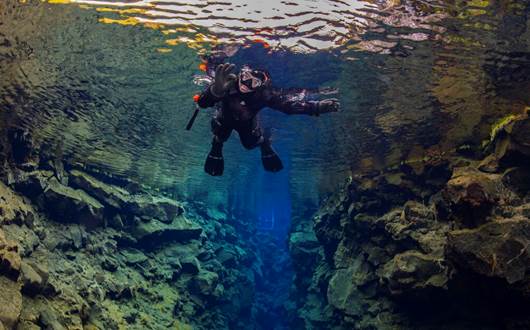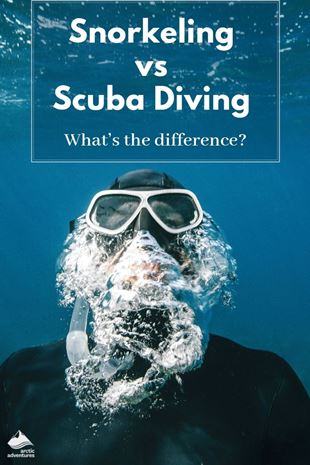
Snorkeling in Silfra: Everything You Need To Know
For a moment, I stop breathing. Not from fear, but from pure awe and wonder. I am experiencing a blend of deep serenity and insane euphoria.
The Silfra Fissure in Southwest Iceland is considered one of the best snorkeling and diving spots on Earth.
You’re in the middle of planning your Silfra adventure, only to ask yourself: snorkeling vs. scuba diving — is there a difference? The Silfra Fissure in Southwest Iceland is considered one of the best snorkeling and diving spots on Earth. In fact, TripAdvisor rated snorkeling in Silfra Fissure as one of the top 5 activities in the world!

Snorkeling vs Scuba Diving
If you’re looking for a casual snorkeling trip, or want to up the ante with some serious scuba diving, then you’ve come to the right place.
But first you need to decide whether you’re a snorkeler or a scuba diver. What’s the difference between snorkeling and scuba diving? How much experience do these activities require? Read on for the answers to all your snorkeling vs. scuba diving questions.
You can’t go wrong with either snorkeling or scuba diving. Both activities are great ways to experience life under the sea! That being said, there are several key differences between snorkeling and scuba diving.
The primary difference between snorkeling and scuba diving is that snorkeling only allows you to swim at the water’s surface, while scuba diving lets you descend deeper into the sea.

Snorkeling vs Diving
Snorkelers only see views from the surface of the water. Scuba divers, on the other hand, can explore the mysteries that lie at the bottom of the ocean.
So now that you know the main differences between snorkeling and scuba diving, what else do you need to know before setting out on your underwater adventure?
Unlike scuba diving, snorkeling calls for little to no previous experience.
You don’t need any prior experience to go snorkeling. Just take a few minutes to learn the basics and you’ll be floating on the water in no time! This guide on what is snorkeling discover everything you need to know.
That being said, you should still be a confident swimmer before you go snorkeling. You don’t need to be an Olympian, but knowledge of the basic swimming strokes will make your snorkeling experience much safer.

Snorkeling in Silfra Fissure, Iceland
Snorkeling is easy and accessible for the whole family. If you dream of one day being able to scuba dive, then snorkeling is the perfect way to dip your toe in the water.
According to TripAdvisor’s 2019 Travelers’ Choice awards, snorkeling in Iceland’s Silfra Fissure is one of the top 5 things to do on Earth! Besides the crystal-clear waters and vast sea floor, the fissure is a geological masterpiece. Silfra Fissure is the meeting point of the North American and Eurasian continental plates. The plates push and pull together beneath the water’s surface, forming a spectacular rift you can glide through.
The Silfra Fissure water remains a steady 2-4°C (35-37°F) throughout the year. That’s far from tropical, but an insulated dry suit will keep you warm while you navigate the waters. That means you can splash into Silfra even in winter!
Scuba diving requires training. Although the process may seem daunting, it’s actually quite simple. With the help of a scuba diving certification course, you’ll be ready to hit the water within just a couple of weeks.

Diving skills training in a swimming pool
In order to start scuba diving, you first need to enroll with a diving agency. The largest and most-established diving agency in the world is PADI (Professional Association of Diving Instructors), although there are several other schools you can choose from.
Your beginner’s diving course will teach you safety procedures, how to use the scuba breathing device, and how to swim deep under the water’s surface. With the help of an expert guide, you’ll perform your first open sea dive.

Certificates you need to Scuba Dive in Iceland
After the beginner’s course, you’ll be rewarded with an Open Water Diver Certification. From there, you can enroll in more advanced training courses in order to refine your diving skills.
In order to scuba dive in the cold waters of Iceland, you’ll need to take an additional course to get Dry Suit certified. These courses are offered in many PADI centers. Luckily, we also offer a PADI Dry Suit certification course right at Silfra! Enroll in our course and be ready to dive between the continents in just two days.
The answer is probably yes! Basically anybody can scuba dive as long as they undergo the proper training. In order to safely scuba dive, you need to be in good health and fairly fit. Scuba diving isn’t recommended for people with serious lung or heart conditions, or for pregnant people. Scuba divers should also be confident swimmers.

Two divers in Silfra Fissure
The minimum age to go scuba diving ranges from 12 to 18 years old, depending on the diving spot. To dive in Silfra Fissure you must be at least 18 years old.
Diving to the ocean floor and breathing underwater may sound daunting, but scuba diving is a low-risk activity. Developments in technology and quality training programs have made diving safer than ever. As long as you’ve been properly trained and follow safety regulations, you have nothing to worry about.

Silfra Fissure is considered one of the best scuba diving spots on Earth. The waters are exceedingly clear, with underwater visibility reaching over 90 m (300 ft). Paddling along the seafloor, explore underwater caves, lava rocks, and forests of seaweed.
As we mentioned earlier, Silfra Fissure is chilly. Temperatures hang around 2-4°C (35-37°F) year-round. In order to scuba dive in such cold waters, you’ll need special dry suit Diver Certification. Once you’re certified, you’ll be able to scuba dive in cold waters the world over.
You can enroll in a dry suit Diver Course if you’ve already received your basic Open Water certification. If you’re set on diving in Silfra, you first need to receive your dry suit certification or log at least 10 dry suit dives.

Getting ready for Diving
Snorkeling and scuba diving require different types of equipment. Generally, scuba diving requires more complicated tools. Let’s take a look at these complete lists of snorkeling and scuba diving gear.

Snorkeling Equipment

Diving Equipment
Almost anybody can be a snorkeler or scuba diver! The best activity for you depends on your experience level and personal taste.
Snorkeling is a low-commitment option that allows you to explore the marine world from the ocean’s surface. If you’re feeling more ambitious, sign up for an Open Water Diver Certification course and go scuba diving. Whatever you choose, you’re bound to have an incredible underwater adventure.
Still not sure whether snorkeling or scuba diving is more your speed? Check out our full list of snorkeling and diving tours in Silfra Fissure!
Best Seller
